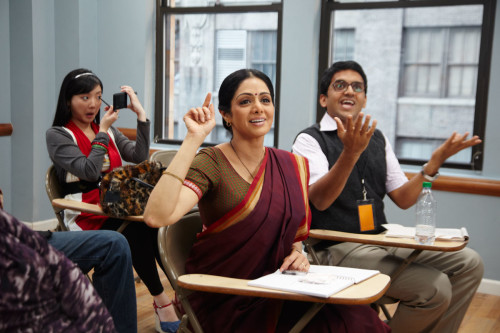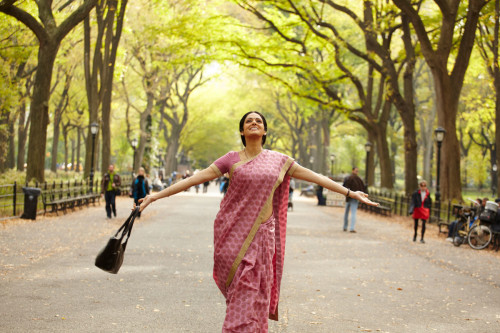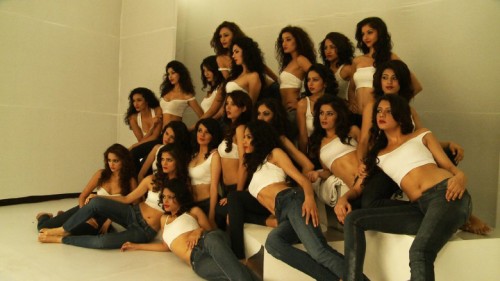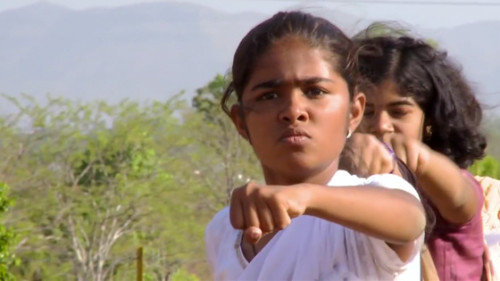This guest post by Asma Sayed previously appeared at AwaaZ Magazine and appears here as part of our theme week on Asian Womanhood in Pop Culture. Cross-posted with permission.
English-Vinglish is a new addition to the increasing number of Indian crossover films—socially progressive films that can still be commercially successful on a global scale. Moving away from the Bollywood style masala and dancing-around-the-trees numbers, this film focuses on the real-life issue of the position of women in the domestic and social spheres in India. Traditionally, many Indian feminist filmmakers such as Deepa Mehta, Meera Nair, Gurinder Chadha and Aparna Sen have made films about subject matter generally not discussed in the mainstream cinema: domestic violence, prostitution and trafficking, sexuality, and women’s rights in general. While these filmmakers continue to direct films with new and varied focuses, it is also exciting to witness the new generation of female directors in India that includes Anusha Rizvi (Peepli Live), Kiran Rao (Dhobi Ghat) and now, Gauri Shinde (English-Vinglish), who are doing excellent work and bringing unconventional cinema and subject matter to audiences. In a country where women’s role in society is very complex—on one hand, there have been female presidents and prime ministers, and on the other, the society remains highly patriarchal and there are the growing concernsrelated to the imbalance in birth sex ratiosresulting from female foeticide—presenting women’s life experiences can be a daunting task.
In her debut film English-Vinglish, Gauri Shinde, the writer and director, takes charge of the issue of women’s role in a society still suffering from the colonial mindset where people’s worth is judged on the base of their proficiency in English. Shashi (Sridevi), the protagonist of the film, is a wife and a mother, and also a good cook. She puts her culinary skills to work by starting a small home-based business selling “laddoos,” an Indian sweet. But Shashi’s knowledge of English is limited, and her tween daughter, the older of the two children in the family, and her husband Satish (Adil Hussain) continuously make fun of her linguistic incompetency. The daughter is embarrassed about her mother’s minimal knowledge of English and does not want Shashi to go to school with her as Shashi will not able to converse in English with other mothers or with the principal of the convent school. Satish is complicit in deriding Shashi’s weaknesses. Shashi feels justifiably belittled and insecure. Nonetheless, despite the lack of appreciation that her family shows toward her, Shashi never sways in performing her motherly and wifely duties. As part of a patriarchal system that she doesn’t explicitly question, she accepts that Satish expects her to have his breakfast ready in the morning, and that shebe ready to warm his bed by night. As such, Shashi spends her time doing all the household chores and running her small business, and never finds a moment for herself.
Incidentally, performing another of her traditional roles, Shashi has to travel to America alone to help her sister plan her daughter’s wedding. Once in America, she reads a billboard advertising English classes that promise fluency in four weeks. Shashi starts attending classes. What follows is reminiscent of the 1970s BBC sitcom Mind Your Language and the follow-up Indian Hindi sitcom titled Zabaan Sambhalke. Shashi’s classmates are from various ethnicities and nationalities; all of them are struggling with their language skills and ultimately become good friends as they learn English. One of her classmates, a Frenchman, Laurent (Mehdi Nebbou), falls in love with Shashi. As the film progresses, Shashi’s husband and children come to Manhattan to attend the wedding. Shashi, who has been making all the arrangements for the wedding, makes laddoos for the party. When Satish makes the statement that —“My wife was born to make laddoos”—Shashi is supported by her niece who reminds Shashi that she is capable of much more than laddoo-making and is far more competent than her husband perceives her to be. At the wedding party, Shashi gives a speech—yes, in English. She reminds the couple getting married, as well as her husband and daughter, of the value of family and the need to support one another without being “judgmental” – a word Shashi has picked up from one of the many English films she has watched to learn the language. After her speech, both Satish and their daughter apologize to Shashi for their ill-manners. However, this repentanceemanates only after Shashi has learned English and in so doing learned her own self-worth. Shashi comes to appreciate herself, her work and her identity, and becomes a more confident woman.
The film is certainly entertaining and well-made. The plot is tight-knit and gripping. The film attempts to showcase the everyday reality of women’s position in male-controlled Indian society. But, ultimately, the message that Shashi imparts in her speech is very conventional.When I watched the movie the first time, I was reminded of an advertisement that I saw in Gujarati newspapers when I was growing up in India. The bold writing at the top of the advert read “modern but good mother.” The advert insisted that a mother who is modern enough to know the world around her would ensure that she used the product it advertised. I never got over the conjunction “but” in that caption. The word posed modernity and motherhood as antithetical – any modern woman had to make a special attempt to simultaneously be a “good” mother. The institution of motherhood is much glamorized in contemporary societies in that a woman is deemed incomplete if she is unwilling or unable to conceive. Motherhood is still considered a central tenet of female identity. And yet, in a changing neoliberal and patriarchal society people fail to see the value of women’s domestic chores including those related to motherhood, and as such mother-work is neither socially respected nor valued economically. This reality is reinforced at the end of the film for Shashi’s role does not change – she is still the same housewife and a doting mother – although one who can now speak English. Shashi’s speech about family values brings her right back to square one; thus, Shashi’s role is static. Therefore, the film does not suggest any radical transformation of women’s social roles. It merely demands from them a higher level of education that, while potentially personally fulfilling, is not intended to challenge their traditional roles and could be argued to be simply placing more pressure on women. Moreover, the audience does not get a glimpse into Shashi’s feelings for Laurent; when her niece questions her about Laurent, all that Shashi says is that she does not need love, but respect. Shashi thanks Laurent for making her feel special, but as a dedicated Indian wife, she is not allowed to have any feelings of her own, and she goes right back to the husband who didn’t appreciate her much – one is to be hopeful that he will be a changed person when they land in India off the airplane from America, but then, can the patriarchal ideologies that have been internalized over the years be forgotten that quickly? After all, following more than six decades of decolonization, India has not unlearned the hegemony of English.
The role of language has been debated continuously in the post-colonial world. While English came to countries such as India and Africa as a result of colonization, it has endured and, in India, now has a much stronger hold than during the colonial period. English has become a tool of what R. Radhakrishnan has called “cultural modernization.” However, English has been a contested language in post-colonial world at large. For instance, while Ngugi Wa Thing’o wrote that “language is a collective memory bank of people’s experience in history” and refused to write in English, Chinua Achebe declared that the language that the colonizers left behind belonged to him. While he decided to use it, he saw it as remade via appropriation: for the English he used had “to be new English, still in full communion with its ancestral home but altered to suit its new African surroundings.” Whether it is Standard English, or appropriated, favoring the language at the cost of indigenous languages is a political move and a culture-altering exercise.
One cannot deny that English has become a lingua franca in India, and that sadly, there is linguistic hierarchy in the nation with English as the ticket to upward mobility. Thus, the fact that in the film, Shashi proves her worth by learning English showcases India’s highly colonialist linguistic history. However, India’s women’s liberation movement can certainly do without adhering to such hegemonic ideologies. At one point in the film Shashi is ecstatic when she learns the word “entrepreneur” – she is told that she was an entrepreneur as she sold sweets. Suddenly, this English word gives new elevated meaning and value to her work, making her feel important and confident. She walks the streets of New York saying the word repeatedly. In showing Shashi’s success through her acquisition of English, Shinde fails to address other issues of a post-colonial nation. Many advertisements and mainstream films in India play on the insecurities of women; for instance, the fairness creams are a huge market in this country where women are always reminded by society and through these ads that dark-skinned women are somehow inferior. Similarly, in this case, those who lack the knowledge of English have to prove their worth by learning the language of the colonizers. In not moving away from a colonialist mind frame, Indians are fulfilling Lord Macaulay’s desire, expressed in his 1835 “Minute on Education,” “to form a class of persons, Indians in blood and colour, but English in taste, in opinions . . . .” It is an irony that in a country which has its own richness of multiple languages, the hegemony of English has outlasted British colonial times.
Ultimately the film is about an Indian woman’s moral and family values – Shashi shows no interest in Laurent, the Frenchman who loves her, nor does she even once abandon her saree and mangal sutra –signifiers of a married Hindu woman – when in America. At the end, Shashi is just an English-speaking, sacrificial Indian woman – not a woman who has awakened to her rights or to her own needs. Shashi’s confidence returns after she found acceptance by a Frenchman, and after her husband and daughter have found her worth enhanced due to her English speaking skills. This is a classic example of patriarchal and linguistic supremacy. Shashi depends on the approval of men to feel good about herself. She also proves her worth by learning English. One does wonder if a single woman speaking Marathi or Gujarati or Tamil or Telugu has anything to feel good about.
An entertaining crossover film, English-Vinglish fails to deliver the feminist message that it may have intended to bring forth. While in various interviews the director has demonstrated her awareness of British colonization and Indian people’s misplaced awe of white people, it is a shame that rather than showcasing the ridiculousness of racialized and colonial insecurities, the film ultimately fails to transmit a message of awareness. Instead this work falls prey to the same stereotypes the director appears to critique.
Dr. Asma Sayed teaches English, Communication Studies, and Women’s Studies in Canadian universities. She has published three books as well as several refereed articles and book chapters, on such topics as diaspora literature, Canadian comparative literature, Indian cinema, and women’s representation in cinema. She writes a film column for AwaaZ: Voices, a periodical in Kenya.











